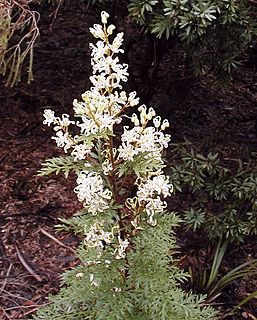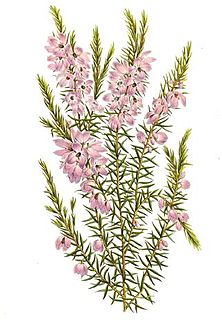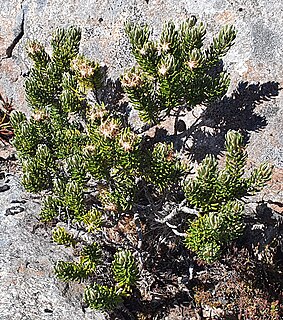
The Xyridaceae are a family of flowering plants. The botanical name has been recognized by many taxonomists and is known as the yellow-eyed grass family.

Lomatia tasmanica, commonly known as King's lomatia, is a shrub of the family Proteaceae native to Tasmania. Growing up to 8 metres (26 ft) tall, the plant has shiny green pinnate (lobed) leaves and bears red flowers in the summer, but yields neither fruit nor seeds. King's lomatia is unusual because all of the remaining plants are genetically identical clones. Because it has three sets of chromosomes and is therefore sterile, reproduction occurs only vegetatively: when a branch falls, that branch grows new roots, establishing a new plant that is genetically identical to its parent.

Epacris is a genus of about forty species of flowering plants in the family Ericaceae. It was formerly treated in a closely related but separate family Epacridaceae, but the various genera within Epacridaceae including Epacris have been revised in their relationships to each other and brought under the common umbrella of the Ericaceae. The genus Epacris is native to eastern and southeastern Australia, New Caledonia and New Zealand. The species are known as heaths or Australian heaths.

Lomatia is a genus of 12 species of evergreen flowering plants in the protea family Proteaceae. Within the family, they have been placed, alone, in their own subtribe, Lomatiinae according to Johnson & Briggs 1975 classification of the family and subsequently in Flora of Australia (1995).

Xyris is a genus of flowering plants, the yelloweyed grasses, in the yellow-eyed-grass family. The genus counts over 250 species, widespread over much of the world, with the center of distribution in the Guianas.

Blandfordia punicea, commonly known as Tasmanian Christmas bell, is a species of flowering plant that is endemic to western Tasmania. It is a tufted perennial herb with linear leaves and drooping red, bell-shaped flowers that are yellow on the inside.

Ewartia planchonii commonly known as creeping cushionherb, is an endemic herb to alpine areas of Tasmania. E. planchonii is commonly found in the western highlands of Tasmania. The Ewartia genus is described as cushion plants/herbs due to the characteristic growth habits of low growing, highly compact mats which are made up of highly packed stems. These mats are slow-growing and are often located in soils that contain low nutrients.

Dracophyllum milliganii is a species of angiosperm in the family Ericaceae and the sub-family Epacridoideae. It is a distinctive alpine shrub, endemic to Western Tasmania.

Gymnoschoenus sphaerocephalus, commonly known as button grass, is a species of tussock-forming sedge from southeastern Australia. It forms part of a unique habitat in Tasmania.

Gahnia grandis is a tussock-forming perennial plant found in southeastern mainland Australia and Tasmania.

Persoonia muelleri, commonly known as Mueller’s geebung, is a shrub endemic to Tasmania. It forms a shrub in open areas of wet forests in the west and northeast of the state. It is occasionally confused with P. gunnii though it has larger flowers and longer, straighter leaves.

Actinotus bellidioides, sometimes known as tiny flannel-flower, is an endemic Australian rosette herb. The species name comes from Bellis, a genus of Asteraceae and Greek oides, meaning "resembles". The name refers to the similarity of the leaves with the genus Bellis.

Cenarrhenes is a monytypic genus in the family Proteaceae containing the single species Cenarrhenes nitida, known as the Port Arthur plum or native plum. Cenarrhenes nitida is an evergreen shrub to small tree endemic to the rainforests and scrublands of western Tasmania. It bears white flowers in late spring followed by the development of fleshy fruit.
Xyris baldwiniana, common name Baldwin's yelloweyed grass, is a North American species of flowering plant in the yellow-eyed-grass family. It is native to southern Mexico (Chiapas), Central America, and the southeastern and south-central United States.
Xyris elliottii, common name Elliott's yelloweyed grass, is a North American species of flowering plant in the yellow-eyed-grass family. It is native to the coastal plain of the United States from Mississippi to South Carolina plus southern Mexico (Tabasco), Central America and the West Indies.

Xyris jupicai, common name Richard's yelloweyed grass, is a New World species of flowering plants in the yellow-eyed-grass family. It is widespread in North America, South America, Mesoamerica, and the West Indies.

Richea gunnii, the bog candleheath or Gunns richea, is an endemic Tasmanian angiosperm. It is a dicot of the family Ericaceae and is found in Central, Western and North-east Tasmania.

Astelia alpina called pineapple grass, silver astelia, or perching lily is a commonly found species in alpine and subalpine areas of Tasmania and the Australian Alps. It is a perennial herb that typically dominates its environment by growing in dense clusters, called mats, in alpine bogs. There are two subspecies: Astelia alpina var. novae hollandiae from New South Wales and Victoria and Astelia alpina var. alpina endemic to Tasmania. Both subspecies appear very similar to each other. The species was originally described by Robert Brown.

Tetratheca pilosa is a flowering plant in the family Elaeocarpaceae, endemic to Australia. It is a small shrub found in dry sclerophyll forests, open heathlands and woodlands of Australia. It was first recorded in 1805 by French botanist Jacques Labillardière.

Olearia ledifolia, commonly known as the rock daisy bush, is a flowering shrub of the family Asteraceae. It is endemic to Tasmania and found at higher altitudes where it grows as a low, compact bush with tough leathery leaves and bears numerous small white daisy-like flowers in summer. The specific name ledifolia is derived from the Greek 'ledos' and the Latin 'folium' (leaf), referring to the hairy under surface of the leaves. It was initially described as Eurybia ledifolia by J.D. Hooker in 1860 and then as O. ledifolia by George Bentham in the 1867 census 'Flora Australiensis: a description of the plants of the Australian territory'.


















